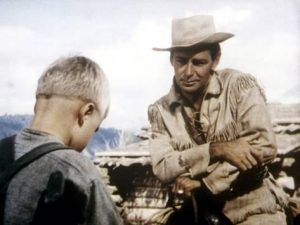What’s the In? What’s the Out?

In the movie biz, there’s a question that studios and development companies often put to any screenplay they’re evaluating:
What’s the in? What’s the out?
What they mean is, “What is this script’s opening image and closing image? Do the two work together? Are they cohesive? Are they on-theme? Are they are far apart emotionally as possible?”

Brandon deWilde and Alan Ladd in “Shane”
This is a really helpful series of questions for any creative person who’s trying to evaluate his or her own work. I use it all the time.
What’s the in? What’s the out?
These questions help if you’re designing a restaurant, writing a Ph.D. dissertation, crafting a speech for a corporate audience. They help for music, for dance, for art, for photography.
And they help for fiction and nonfiction.
The classic Hollywood example of a great “in” and an even greater “out” comes from the 1953 Western, Shane, starring Alan Ladd, Van Heflin, Jean Arthur, Brandon deWilde and Jack Palance, directed by George Stevens and written by A.B. Guthrie, Jr. and Jack Sher from Sher’s 1949 novel (that he wrote as Jack Schaefer.)
Here’s the in:
A lone rider (Alan Ladd) descends from a mountain pass into a gorgeous Wyoming valley, circa 1870. In the audience we can tell from the rider’s fringed buckskin jacket, from his horse’s silver trimmed bridle, and from the six-gun on his hip that he is not your ordinary cowpuncher.
The camera cuts ahead to a small ranch-a-building (apparently a sodbuster’s claim), where a tow-headed boy of six named Joey (Brandon deWilde), looks up and sees the rider approaching. Even at a distance the horseman cuts a figure of romance—and the boy responds to it.
JOEY
Somebody’s coming, Pa!
Van Heflin plays Joe Starrett. It’s his little ranch that Alan Ladd is approaching.
JOE STARRETT
Well, let him come.
Now the out:
The same lone rider now exits the valley. It’s night. He’s been wounded, shot in the side after gunning down the three prime Bad Guys (including Jack Palance as the archetypal black-hatted gunslinger, Wilson), who were “putting the run on” the honest, hard-working sodbusters.
Shane clearly doesn’t want to leave. He is compelled by his own fate.
SHANE
Joey, there’s no living with a killing. There’s no going back from it. Right or wrong, it’s a brand. A brand sticks.
JOEY
But, Shane, we want you! Mother wants you, I know she does!
Shane tousles Joey’s hair in farewell. He rides out of the valley, the exact way he came.
JOEY
Shane, come back! Shane!
Even if we know nothing of what came between these two scenes (by which I mean the entire body of the movie), we get a pretty good sense of the narrative just from this “in” and this “out.”
What’s yours?
If you’re designing a restaurant, what’s the first impression people get when they enter? What’s the last thing they see when they leave?
What’s the first song on your album? What’s the last?
What’s the entry action in your videogame? What’s the exit?
[We’ll get into this subject of “ins” and “outs” a little deeper over the next few weeks.]
BTW, Shane was picked by the American Film Institute as the #3 US Western of all time, behind The Searchers and High Noon.
Myself, I would put it at Number One.




As a reader, the ‘in’ entices me in for the ride but the ‘out’ is what stays with me. A truly great ‘out’ lingers for days and weeks and years. ‘I Am Legend’ is an example.
Looking forward to Steve’s advice on how to create a great and memorable ‘out’.
Very useful idea, not one I thought about yet. And perfect timing for me!
Today’s Writing Wednesday brought “back” the dream of my 5-year old in 1990 at the age of my early 50’s (the “in) and then what I wrote 8.11.2018 at the age of 80 (the “out”). Will I be able to write “the story” of the “in between time?” I HONESTLY DO NOT KNOW. No doubt [FIRST] I will have to remove the “cap” of RESISTANCE.
This is a very helpful way to highlight the importance of the “bookends” of the story – as always, thanks!
“What’s the in? What’s the out?” Such a great way of putting it. Simple and to the point. Bookend scenes. Wonderful insights, so graphic. . A truly great “out” really does linger, so true, as Madeleine said. Looking forward to your series on this. Your advice is always such an eye opener.
Brilliant! Thanks – good test for anything.
Brilliant.
Helpful and appreciated – a series of questions I’ll keep handy. Thank you, Mr. Pressfield!
Appreciate ya Steve.
You have this right, Steve.
I love this quote by Mickey Spillane: “The first page sells this book. The last page sells the next one.”
“What do you make of him Shane?”
“He ain’t no cowpuncher.”
From when Wilson and Shane first meet. Classic Western…
That is one of the best metaphors that I have heard about knowing what to do in your life! I am going to start thinking about my writing like that. Every piece I write will be based on this in/out principle.
Thanks for sharing.